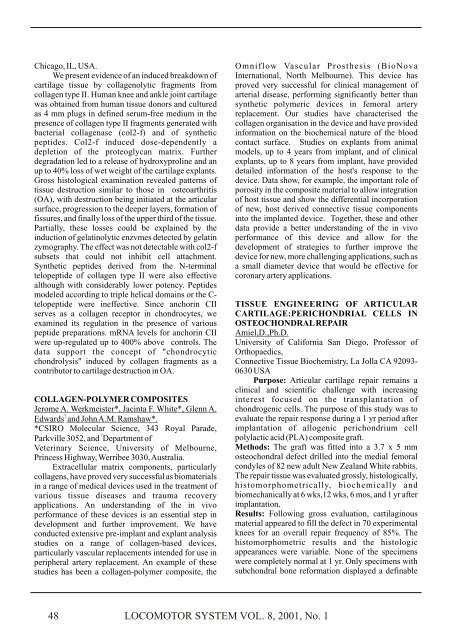1/2001 - SpoleÄnost pro pojivové tkánÄ›
1/2001 - SpoleÄnost pro pojivové tkánÄ›
1/2001 - SpoleÄnost pro pojivové tkánÄ›
Create successful ePaper yourself
Turn your PDF publications into a flip-book with our unique Google optimized e-Paper software.
Chicago, IL, USA.<br />
Omniflow Vascular Prosthesis (BioNova<br />
We present evidence of an induced breakdown of International, North Melbourne). This device has<br />
cartilage tissue by collagenolytic fragments from <strong>pro</strong>ved very successful for clinical management of<br />
collagen type II. Human knee and ankle joint cartilage arterial disease, performing significantly better than<br />
was obtained from human tissue donors and cultured synthetic polymeric devices in femoral artery<br />
as 4 mm plugs in defined serum-free medium in the replacement. Our studies have characterised the<br />
presence of collagen type II fragments generated with collagen organisation in the device and have <strong>pro</strong>vided<br />
bacterial collagenase (col2-f) and of synthetic information on the biochemical nature of the blood<br />
peptides. Col2-f induced dose-dependently a contact surface. Studies on explants from animal<br />
depletion of the <strong>pro</strong>teoglycan matrix. Further models, up to 4 years from implant, and of clinical<br />
degradation led to a release of hydroxy<strong>pro</strong>line and an explants, up to 8 years from implant, have <strong>pro</strong>vided<br />
up to 40% loss of wet weight of the cartilage explants. detailed information of the host's response to the<br />
Gross histological examination revealed patterns of device. Data show, for example, the important role of<br />
tissue destruction similar to those in osteoarthritis porosity in the composite material to allow integration<br />
(OA), with destruction being initiated at the articular of host tissue and show the differential incorporation<br />
surface, <strong>pro</strong>gression to the deeper layers, formation of of new, host derived connective tissue components<br />
fissures, and finally loss of the upper third of the tissue. into the implanted device. Together, these and other<br />
Partially, these losses could be explained by the data <strong>pro</strong>vide a better understanding of the in vivo<br />
induction of gelatinolytic enzvmes detected by gelatin performance of this device and allow for the<br />
zymography. The effect was not detectable with col2-f development of strategies to further im<strong>pro</strong>ve the<br />
subsets that could not inhibit cell attachment. device for new, more challenging applications, such as<br />
Synthetic peptides derived from the N-terminal a small diameter device that would be effective for<br />
telopeptide of collagen type II were also effective coronary artery applications.<br />
although with considerably lower potency. Peptides<br />
modeled according to triple helical domains or the C-<br />
telopeptide were ineffective. Since anchorin CII TISSUE ENGINEERING OF ARTICULAR<br />
serves as a collagen receptor in chondrocytes, we CARTILAGE:PERICHONDRIAL CELLS IN<br />
examined its regulation in the presence of various OSTEOCHONDRAL REPAIR<br />
peptide preparations. mRNA levels for anchorin CII Amiel,D.,Ph.D.<br />
were up-regulated up to 400% above controls. The University of California San Diego, Professor of<br />
data support the concept of "chondrocytic Orthopaedics,<br />
chondrolysis" induced by collagen fragments as a Connective Tissue Biochemistry, La Jolla CA 92093-<br />
contributor to cartilage destruction in OA.<br />
0630 USA<br />
Purpose: Articular cartilage repair remains a<br />
clinical and scientific challenge with increasing<br />
COLLAGEN-POLYMER COMPOSITES<br />
interest focused on the transplantation of<br />
Jerome A. Werkmeister*, Jacinta F. White*, Glenn A. chondrogenic cells. The purpose of this study was to<br />
<br />
Edwards and John A.M. Ramshaw*.<br />
evaluate the repair response during a 1 yr period after<br />
*CSIRO Molecular Science, 343 Royal Parade, implantation of allogenic perichondrium cell<br />
<br />
Parkville 3052, and Department of<br />
polylactic acid (PLA) composite graft.<br />
Veterinary Science, University of Melbourne, Methods: The graft was fitted into a 3.7 x 5 mm<br />
Princess Highway, Werribee 3030, Australia.<br />
osteochondral defect drilled into the medial femoral<br />
Extracellular matrix components, particularly condyles of 82 new adult New Zealand White rabbits.<br />
collagens, have <strong>pro</strong>ved very successful as biomaterials The repair tissue was evaluated grossly, histologically,<br />
in a range of medical devices used in the treatment of histomorphometrically, biochemically and<br />
various tissue diseases and trauma recovery biomechanically at 6 wks,12 wks, 6 mos, and 1 yr after<br />
applications. An understanding of the in vivo implantation.<br />
performance of these devices is an essential step in Results: Following gross evaluation, cartilaginous<br />
development and further im<strong>pro</strong>vement. We have material appeared to fill the defect in 70 experimental<br />
conducted extensive pre-implant and explant analysis knees for an overall repair frequency of 85%. The<br />
studies on a range of collagen-based devices, histomorphometric results and the histologic<br />
particularly vascular replacements intended for use in appearances were variable. None of the specimens<br />
peripheral artery replacement. An example of these were completely normal at 1 yr. Only specimens with<br />
studies has been a collagen-polymer composite, the subchondral bone reformation displayed a definable<br />
48 LOCOMOTOR SYSTEM VOL. 8, <strong>2001</strong>, No. 1
















